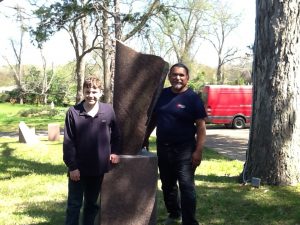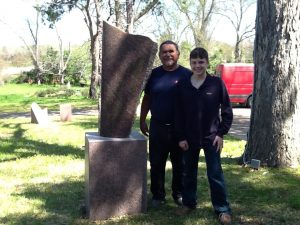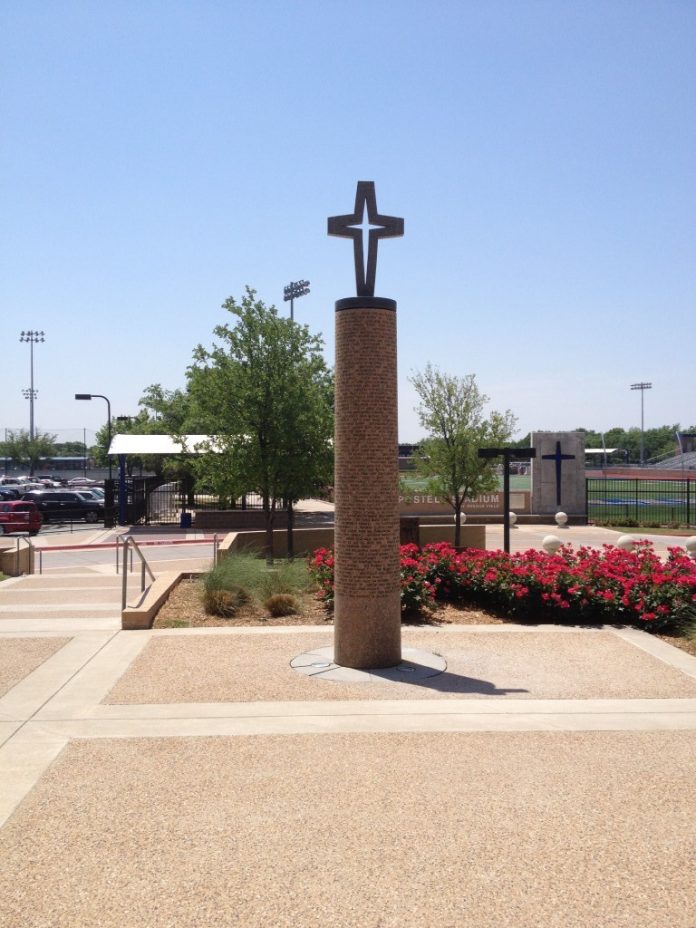It was the morning drive to Jesuit, and it is noticed by all. A giant square of granite that fell on the grass? It looks like something from 2001: A Space Odyssey! But what is it? Where did it come from? Who made it? Why was it made? The answer: Jesús Bautista Moroles.
Born in 1950 in Corpus Christi, Moroles has achieved renown in the world of arts. His widely-known granite sculptures grace numerous nations including: China, Egypt, France, Italy, Japan, Switzerland, the US, and others. His commitment to sculpture reflects upon his 2008 National Medal of Arts Award given by President George W. Bush. “I make art because, without art, we would be a society without culture,” Moroles has said. Since he preaches and promotes art, he claims it to be “his religion.”
 Through the contributions of his friend and Jesuit graduate Frank Ribelin ’50, our school luckily possesses two of Moroles’s works. First, he chiseled a granite pillar honoring former Jesuit President Father Philip S. Postell S.J., etched with donor names and a trickling waterfall, located near the athletic tower entrance. Second, he designed a granite square that rests on the green grass overlooking Inwood Road.
Through the contributions of his friend and Jesuit graduate Frank Ribelin ’50, our school luckily possesses two of Moroles’s works. First, he chiseled a granite pillar honoring former Jesuit President Father Philip S. Postell S.J., etched with donor names and a trickling waterfall, located near the athletic tower entrance. Second, he designed a granite square that rests on the green grass overlooking Inwood Road.
At first glance, many of his works of art seem no more than chunks of rock, but that depends on the definition of art. “Art can be many things. Even life is art.” Moroles expresses his interest in the environment as well as the culture around him. His works reflect the collaboration of both nature and man using rough and smooth surfaces of granite.
When producing a work of art, Moroles goes in blind! He does not even have an idea of what the piece will be. The artists simply obtains a block of granite and starts carving away with a chisel and hammer. If he happens to commit an accident, but wait! Moroles insists that, “There are no accidents. Everything has a reason.” A piece of granite “mistakingly” falls away, and he carves on as if it was supposed to fall.
Although Moroles originally designed the piece on the school’s front lawn for a show in North Dallas, it moved to Jesuit for a purpose. He believes that  his famous square, or the “Window,” should be a mascot for Jesuit. Why? The giant granite square not only exists as a place for students to sit, but as a symbol for an opening to knowledge, education and respect.
his famous square, or the “Window,” should be a mascot for Jesuit. Why? The giant granite square not only exists as a place for students to sit, but as a symbol for an opening to knowledge, education and respect.
Speaking of respect, Moroles believes that it is absolutely fine to play with art or climb on it only if you know the work’s position. “Position is the fragility of the art. Art is respect,” Moroles claims. In many cases, art may be designed for interaction and entertainment as long as it is treated with respect. In our case, students perch on Window, but don’t harm it, for they recognize the work’s significance and value.
Undoubtedly, the sculptor loves and cares for art. He also enjoys the fact that Jesuit owns a museum within its walls. “All schools should have art in their walls. All schools should be like Jesuit,” he said. He asks the students to admire the art on campus with respect.






